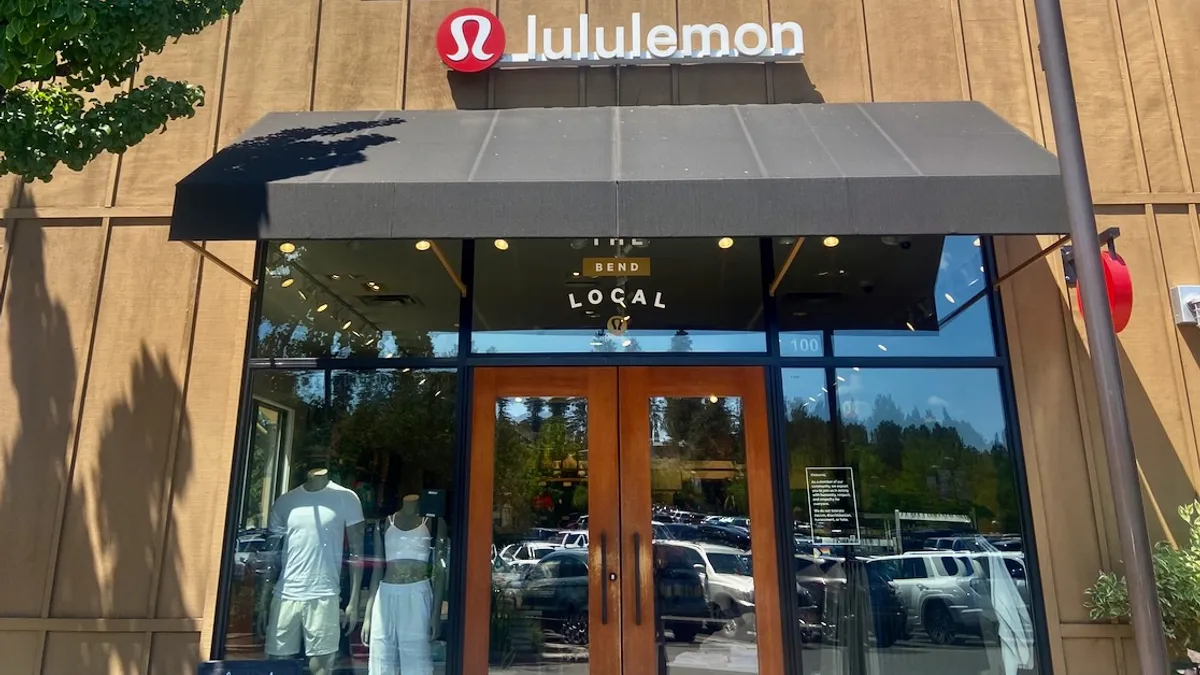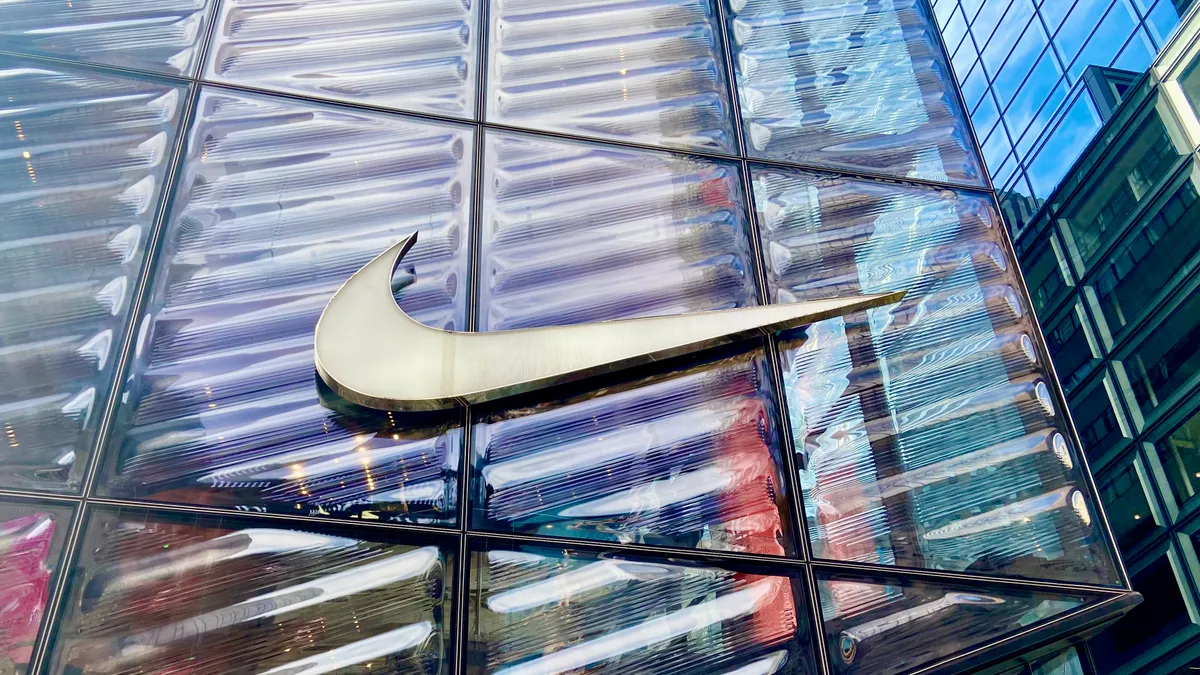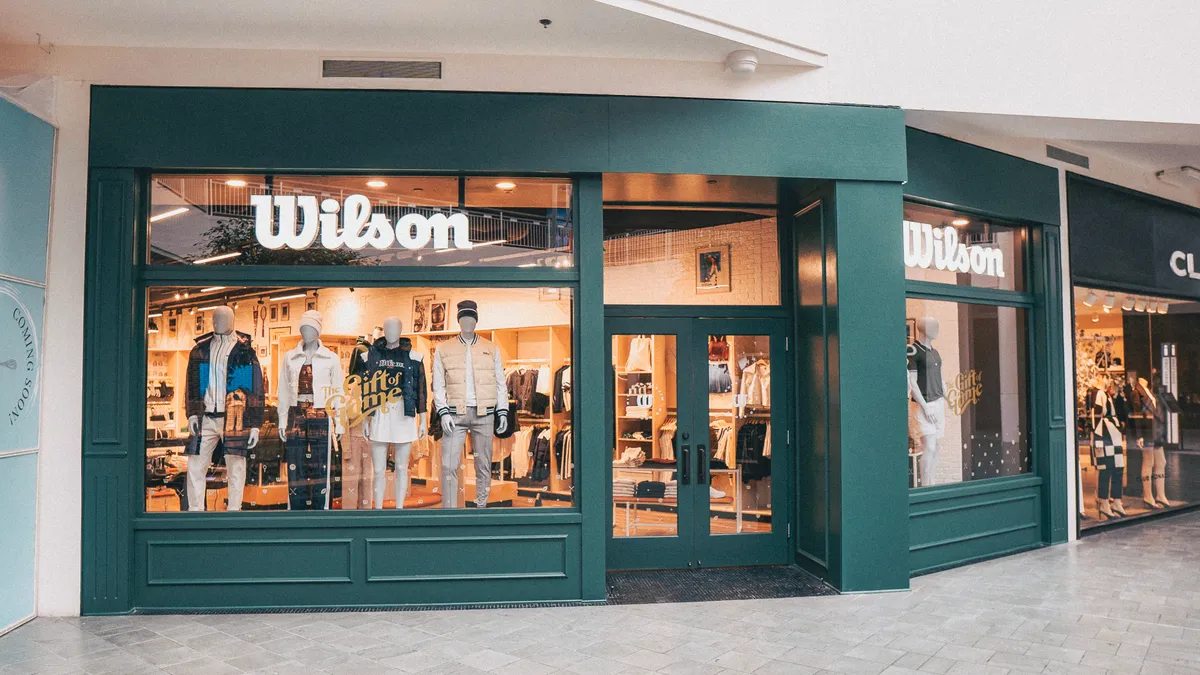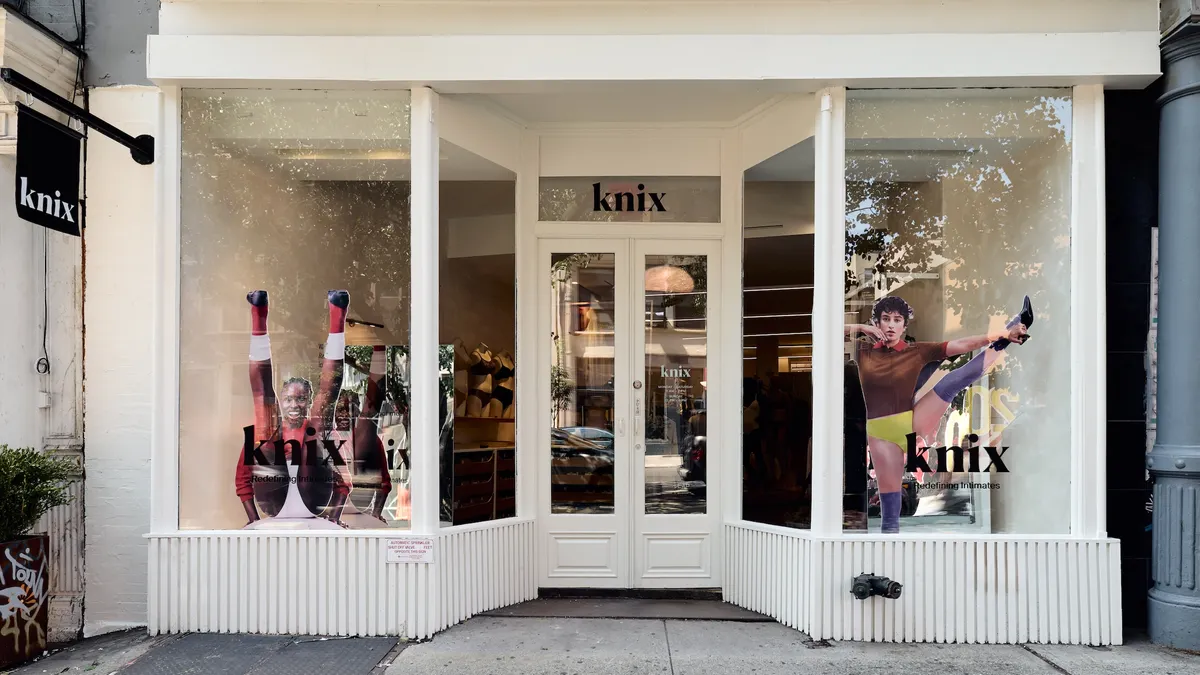This year has been rough for J.C. Penney. Already in 2018, the department store retailer cut hundreds of jobs, disappointed investors in consecutive earnings reports and struggled to significantly improve apparel sales after taking dramatic steps to do so last year.
While some analysts still see the retailer as one of the stronger remaining players in the department store world, others are losing their patience with the company's turnaround efforts, which have yet to yield permanent positive profits or comparable sales growth. And that turnaround plan was just complicated by the sudden resignation of Penney's chief executive.
As 2018 unfolds, Penney, under CEO Marvin Ellison — who announced his resignation Tuesday — has been doing what a lot of its department store peers are doing: figuring out what customers still like about them and doubling down on those areas, while building out digital capabilities and trying to capture market share in any category Penney can find it.
Put another way, Penney has been operating within the parameters of the mall-based department store, while also operating with a sizable debt load on its books. The retailer may well stay the course set by Ellison, but now, on top of its other struggles, there is a leadership vacuum to fill.
In the long-term, Penney may have even bigger problems. Some question whether the retailer, which closed more than 140 stores last year, can ultimately survive the large-scale transformation of retail, as lower-tier malls continue their decline and as e-commerce and discount sellers expand.
"I just don't see a strategy that makes them relevant," Nick Egelanian, president of retail development consultants SiteWorks International, told Retail Dive. "If they had a chance of not making themselves obsolete, that chance came 30 years ago."
Anchored to malls
In the 1960s, J.C. Penney underwent a major transformation as an evolution unfolded across retail as much of the middle class settled in the suburbs.
A mainly softline retailer then, Penney was trying to become a department store chain. In the process, the company — originally founded by James Cash Penney, who built his first dry-goods store in Wyoming in 1902 — anchored itself to the fate of the suburban mall. Bill Moscarelli, a retired shopping center executive, started his career with Penney in those years, while the retailer was trading in its 30,000-square-foot stores for 200,000-square-foot department stores meant to compete with the likes of Macy's and Sears.
Moscarelli recalls one day from that era, when he flew in a plane to the sites of four malls under construction in Ohio, all perhaps within a 60-mile radius of each other, if not less. "Four sites — they were brand new shopping centers," Moscarelli told Retail Dive in an interview. "There was a Penney in every one. And a Sears, and a Montgomery Ward."
Penney was building at a furious pace at the time, working with developers to plant a flag in the great expansion of suburban retail. "It couldn't really exist forever," Moscarelli said.
It didn't. The suburban mall has been in decline for years, decades even, and the entire department store sector has been scrambling to adjust.
Customer rebellion
The arrival of Ellison, a former Home Depot executive, in late 2014 marked a change in the company's trajectory. The two years prior had been marked by heavy losses and the disastrous stint of Ron Johnson, the former Apple executive who tried to reboot Penney's business and brand.
Johnson, who spearheaded Apple's much-lauded retail business, was ousted in spring 2013. During his tenure as CEO, the retailer set about trying to transform itself nearly instantaneously with a new, simpler pricing scheme (no more sales!) and in-store brand shops. "We want to become famous for irresistible style at incredible value every day," Johnson said in a press release at the time, as he rolled out changes across the company's store fleet without testing them first.
As the New York Times recounted at the time of Johnson's departure, "Within weeks of his January 2012 presentation to investors about the future of Penney, the company had new advertising, new pricing and a new logo, and was announcing a new fleet of designers who would be creating collections for it."
But customers balked at some of the changes, including the new price schemes, which began even before the inventory hit stores. As the Times noted, "Customers rebelled, traffic declined, sales fell and Penney slowly returned to the [previous] era of pricing, with lots of promotions, lots of price-focused ads and marked-up prices that would be marked down."
The company posted net losses of $795 million in 2012, $1.3 billion in 2013 and $717 million in 2014. Comparable sales in 2012 fell a harrowing 25%. The next year, the company added more than $2.5 billion in debt to its books. Into the breach stepped Ellison, who had overseen Home Depot's stores and was known for a focus on operations and holding down costs. He took sole control of the CEO position in 2015, but much damage had already been done.
"When you lose customers, it's very difficult to get them back," Paul Vogel, a real estate consultant who helped oversee J.C. Penney's expansion in the 1960s, told Retail Dive. "[Johnson's] idea was to get rid of sales and have everyday low prices. His thinking was Penney needed to be more of a specialty-type retailer, rather than a mass merchant or discount-type player. He alienated much of the shopper base. They liked the sales, they liked private labels."
And now, the exec leading Penney's turnaround is leaving. On Tuesday, Penney announced Ellison was leaving for the top spot at Lowe's, where he'll return to his roots in the home improvement sector — one of the bright spots in retail right now. Ellison is set to depart on June 1.
Ronald Tysoe, the company's new chairman after Ellison stepped down as board chair Tuesday, has created in Ellison's place an "Office of the CEO," comprised of current high-level execs to run the retailer while it searches for a new chief. Cowen analyst Oliver Chen said in a Tuesday note he expected the search to take around six months or more.
Chen described Ellison's departure as "difficult news," as many of the CEO's initiatives are still ongoing and his "strengths in appliance execution and leadership skills will be difficult to replicate." Chen said that Penney, in searching for a replacement, should target someone with a "robust understanding/appreciation" of digital retail, a record of apparel execution, and pricing and marketing skills.
Betting on beauty, filling the Sears void
Under Ellison's leadership, Penney has been largely successful at stemming the flow of sales and money out of the company. It even made a profit in 2016 — which it followed up with a $116 million loss in 2017.
Investors and other observers have become jittery, wondering when the company's turnaround will show permanent bottom- and top-line improvements. In March, Penney said it had slashed 360 jobs at its home office and support teams, on top of another 670 jobs cut as it closed a distribution center the previous month. The moves followed a fourth quarter of top-line sales growth, comparable sales growth and positive profit — but sales figures missed analyst projections.
Penney's first quarter 2018 numbers were worse, with top-line sales declines, comps that barely budged upward and a loss of $78 million — all of which fell short of expectations. Executives attributed the slow-down to a cool start to the spring, but rival Macy's posted strong sales growth during the same period. The day of the Q1 release, the company's stock traded as low as $2.65 per share, less than half of its (still pretty low) 12-month high last July of $5.56 per share.
Nevertheless, Ellison has projected optimism about the company's direction. He pointed out in a March conference call that for 2017 Penney posted positive comps, boosted adjusted earnings per share by 175% and reduced outstanding debt by $600 million.
In the company's stores, Ellison has called out the beauty segment, led by the retailer's partnership with Sephora, as the No. 1 highlight. Last year, Penney opened 70 new Sephora locations, bringing the total to 641 — or 75% of the retailer's stores — by the end of Q4. Penney's jewelry business also posted double-digit comps in Q4. Already beauty is becoming a key part of the retailer's strategy, and Ellison apparently views it as a major competitive advantage.
"J.C. Penney is the only retailer that could offer our customers [a] total beauty solution combining Sephora, salon and fine jewelry under the same roof," he said in March. "This unique beauty experience cannot be replicated online and magnif[ies] the importance and relevance of our physical stores."
Penney also posted double-digit comps in its home segment every quarter last year, thanks to a "strategic decision," in Ellison's words, to dig deeper into the category. The move includes an expanded assortment of appliances, mattresses, furniture, workwear and installations. The strategy is one, partly, of opportunity. As Ellison noted, "[W]e have a large competitor in this space, donating market share."
"Penney is pretending they're operating in a vacuum, and they're not."

Nick Egelanian
President, SiteWorks International
He didn't name the competitor in the March call, and he didn't need to. Penney has only one direct rival in the department store sector that relies on appliance sales and is "donating share" at a rapid clip. Long in Sears' shadow, Penney has a chance to cash in on the former retail behemoth's speedy decline. In 2017, Sears — which has roughly half the retail footprint it did six years ago — closed approximately 400 stores. Ellison said his company has identified 300 malls where it will "aggressively pursue this unprecedented sales opportunity in 2018." In a May conference call, Ellison said Q1 appliance comps grew 15%.
Not everyone sees wisdom in the move. "Their rationale is, 'Well, Sears is failing, and Sears is in malls and we're in malls, so we're going to get some of those sales,'" Egelanian said of the appliance strategy. "Guess what guys, Sears has lost a lot of that business already, and guess who got it: Home Depot and Lowe's. And if Sears is going to lose more of that business, it's going to go to those guys."
He added, "Penney is pretending they're operating in a vacuum, and they're not."
Other analysts have seen progress in Penney's turnaround efforts. Analysts with Morgan Stanley led by Kimberly Greenberger have noted several times, "Of all the department stores, we view [J.C. Penney's] top-line initiatives as the most promising." Deborah Weinswig, founder and CEO, Coresight Research told Retail Dive in an email in early May the Penney comparable sales growth fell short of Kohl's, but ahead of Macy's.
'Omnichannel excellence'
Beyond the growth in beauty and appliances, J.C. Penney upped its omnichannel game in recent years as well, which retail analysts typically see as a necessary investment in the industry's future.
"In my two years as CEO, we've been committed to transforming J.C. Penney from a company focused primarily on the brick-and-mortar business to a true omnichannel retailer," Ellison said in March, adding that in 2017, the retailer grew its online SKU count by 50% and plans to add another 600,000 SKUs online in 2018.
Ellison also said then that 80% of the company's inventory was eligible for free same-day pickup and that 40% of online orders were being fulfilled via Penney stores. In the same call, he also announced that the company was making cuts to its IT and omnichannel teams to "streamline the organization and accelerate decision-making."
"In my two years as CEO, we've been committed to transforming J.C. Penney from a company focused primarily on the brick-and-mortar business to a true omnichannel retailer."

Marvin Ellison
CEO, J.C. Penney
The investments have won the company praise. Cowen analyst Oliver Chen said in a March note that Penney was "taking steps on a path to omnichannel excellence." Chen added, "We're especially encouraged by stores fulfilling 40% of digital orders given strong attachment rates when customers pick-up items," given that execs have said one-third of customers who do so purchase another item, averaging around $50.
But as much as digital improvements might help sales at Penney, as well as its peers who are trying to adapt to the explosive growth of e-commerce, they come with a different cost structure than store sales. In Q4, the company noted improvements in the costs of goods sold were partially offset by growth in online sales.
In a May report, Morgan Stanley analysts pointed out that even as retailers have shrunk their store fleets, their margins are eroding as the "lion's share of retailer growth" comes through e-commerce, which has lower margins than store sales. In the analysts' view, retailers have been caught in a "margin downdraft" since 2012, during which time margins have shrunk by 230 basis points. That outcome is due mainly to e-commerce competition, the rise of price transparency, shifts in retailers' own sales from stores to online and the high cost to retailers of free shipping.
'A huge amount of debt'
With its flat comps and a small decrease in top-line sales, Penney looks to be in much better shape than Sears, which hemorrhaged sales last year and reported a 13.5% decline in comps. That may be a low bar for Penney, but the retailer, along with its mall positioning and troubled sector, shares a fundamental challenge with Sears: a big debt load.
For 2017, the company's total debt stood at $4.2 billion and its net interest expense paid in the year was $325 million — nearly double Penney's operating income. Its cash-to-debt ratio was just under 11% — down about 7% from the previous year. Data from CreditRiskMonitor, a service that tracks bankruptcy risk based on several metrics and data streams, currently indicates that Penney has between a 4% and 9.99% chance of filing for bankruptcy within the next 12 months.
"They have a huge amount of debt, which they've refinanced. That pushed doomsday out for them," Vogel said. "They're in a very difficult operating position. The competition is moving very fast. The good players out there are getting very sophisticated."
Penney's debt load, of course, is not a death sentence, but it does reduce the retailer's margin for error, and it weighs on Penney's ability to adapt to a rapidly evolving world. For example, in late October, when Penney announced a likely Q3 loss — following a move to clear out women's apparel through steep discounts as it revamped assortment ahead of the holidays — analysts with S&P Global issued a negative outlook for the retailer.
S&P analysts said then, "While we believe the recent liquidation of apparel inventory is an isolated event aimed at improving prospects for the coming quarters, any meaningful underperformance of their recent guidance or our expectations could signal that [Penney] has significant issues with its business strategies and operating model." No downgrade has come yet, but the episode shows how little wriggle room Penney has.
As it pays hundreds of millions of dollars in interest every year and tries to build lasting profitability, the company has been cutting costs by shuttering locations and cutting staff, among other moves. The effects can be seen at the stores. According to a Wall Street Journal analysis, Penney has 112 employees for each store, down nearly 123% from a decade ago — a rate of store-level staff cutting that was twice that of the department store sector.
'A long, slow decline'
In the long-run, J.C. Penney and its department store peers face steep existential challenges. Mass merchants have been cutting into their share for years. Amazon and other online players have been stealing apparel sales. And off-price sellers have been growing like gangbusters, as customers seek out steep discounts and "treasure hunt" thrills. That growth has and will likely continue to come at the cost of department store sales.
In May, Ellison said that Penney was facing "the most challenging and competitive retail market we've seen in 50 years."
Yet most of the retailer's challenges aren't new. "They've been on a long, slow decline," Vogel said of Penney. Vogel, a geographer by training, started at Penney at a time when there still weren't many suburban malls around. The company worked directly with developers — some of whom balked at the idea of Penney trying to transform itself into a full-line department store — to build malls with J.C. Penney as an anchor, according to Vogel. "They were opening 50, 60 stores a year. It was an amazing time," he said.
"They are in regional malls almost exclusively. They really should have started looking at getting out of malls sooner, exploring stand-alone locations or big box centers."

Paul Vogel
Real Estate Consultant
During the 1960s and 70s, the retailer had firmly planted its flag in the mall, where it largely stays — even as customers move on. For the past 30 or so years, the problem for Penney, in Vogel's view, has been location.
"They are in regional malls almost exclusively," he said. "They really should have started looking at getting out of malls sooner, exploring stand-alone locations or big box centers. There's no silver bullet in this business. Some of the stores in regional malls were doing just fine. If they're doing just fine, leave them alone. But there were many that weren't doing fine."
Egelanian, who joined the industry in the late 1980s, said when he started working in retail "you really weren't a serious player unless you were in the mall industry." But even then, he added, the mall retail sector was "starting to show cracks" as the more convenient power centers and often lower-priced category killers — i.e., big box retailers specializing in a category that might be found at a department store like Penney — started to redefine retail. By the early 90s, "big box was really starting to take off," he said.
And it kept on going, to the detriment of department stores.
'One of the winners'
Along with the geographical and competitive woes, Moscarelli said that Penney "never seemed to follow through on anything." He pointed out the company pulled out of business ventures in Chile, Brazil, Mexico and other international markets. In the U.S., it sold off a pharmacy business and a discount chain. "Everything was: ‘Well, this is not our thing,'" Moscarelli said. (He was not at Penney during those business moves, but worked alongside them in adjacent businesses during some of the retailer's South American expansion.)
At the same time, Penney hasn't specialized in much besides apparel, where it relies on its private label brands. Vogel said customers historically have been loyal to those brands — such as St. John's Bay, Liz Claiborne, Arizona Jean Company and others — but "didn't try to appeal to new shoppers with new label lines."
In apparel, the company competes with Macy's and Kohl's — retailers with stronger balance sheets and, in the case of Kohl's, more favorable geography. Amazon is also a growing apparel threat and gunning for the No. 1 spot. At the same time, off-price sellers like TJX Cos. and Ross Stores are covering the country with new stores.
Ellison said in May that apparel was the "lynchpin" to the company's strategy and key to its performance over 2018. But Penney is also playing catch up in women's apparel, where casual and athleisure has changed the category. In May, executives told investors that women's activewear sales grew in double digits in Q1, after the company rebooted the category in Q3.
Managing Director of GlobalData Retail Neil Saunders noted in May that Penney is barely profitable at the operating level. (Its operating income in Q1 was $3 million.) "What it needs to do is develop more compelling own-brands in all categories and curate these in a way that is meaningful to its target customer," he said. "This would strengthen the whole business and would encourage shopping across departments."
More broadly, Saunders added, "As much as we recognize many of the positive changes J.C. Penney has made to date, and as much as we respect the highly engaged management team, we believe that now is the time to up the pace of change with bolder and more ambitious moves across all categories."
Ellison — who is getting ready to leave the sector's troubles behind him — has assured the world that Penney is taking the right steps and the turnaround is showing results, but more time is needed for them to fully change the company's trajectory. "[R]etail in the U.S. is a multi-trillion dollar industry. And we believe there can be multiple winners," he said in March, adding that the retailer planned "to be one of the winners."
About two months later, Ellison's headed off the court to go play for another team.
A previous version of this story misstated J.C. Penney's 2013 income due to a rounding error.





















